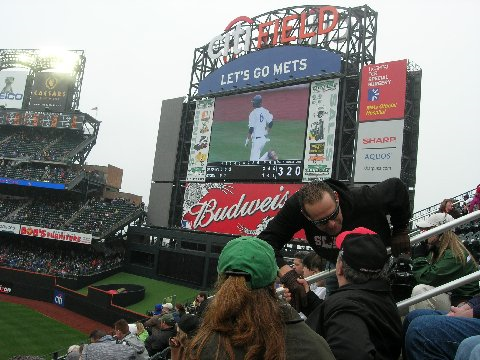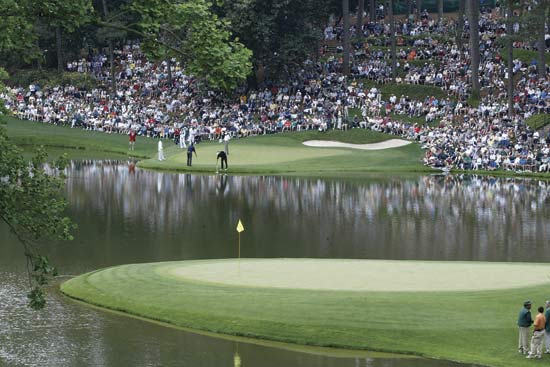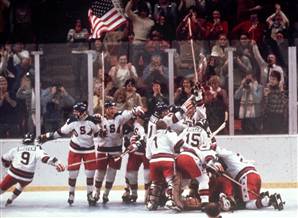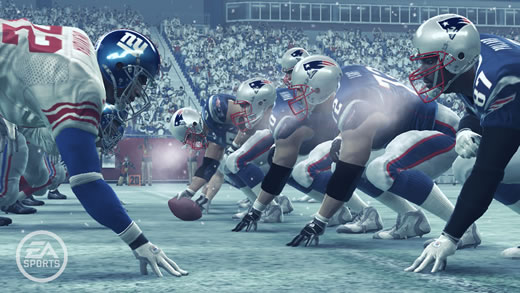Sports Media: Tensions and Transitions

“Film study creates the game plan, in which you’re trying to out-think or out-maneuver the other guy. … You need to have options for every move or countermove, and you identify your best options by studying film. That way, in each situation, you’re reacting rather than deciding.” — Mike McCarthy, Green Bay Packers head coach1
“Basically in football, if you follow the ball, or in baseball if you follow the runner and the ball, or in basketball if you follow the ball, you’re not going to get into trouble. In golf, you have up to 20 balls in play at one time, all of which have to be covered well.”
— Sean McManus, president of CBS Sports2
At FLOW’s 2008 conference, I convened the roundtable discussion “Televised sports and its contexts.” The contributors approached sports from a variety of perspectives. Some addressed aesthetics and style, while others questioned sports’ vivification of race/gender/class issues. Some proffered historiographic queries with regard to sports’ importance in the overall scheme of TV history, and others addressed the “lowbrow” reputation of sports such as mixed martial arts. All of these lines of inquiry pointed toward one ultimate direction: sports on TV is not studied heavily by media scholars. But it should be.
Sports should be seen as a kind of holy grail for media scholars. Mediated sports represents a Petri dish of fan studies (it could be argued that sports fans are the original fanatics), new media and style, participatory production and industrial/economic import, just to name a few areas. Sports coverage on television is an interesting subset of the discipline of television studies for one important reason: sports programming is often broadcast live. There is a certain thrill of “liveness” to a sports broadcast; that is, viewers often tune in to find out how a certain athletic event might unfold. There is always an opportunity to see something historic like Michael Phelps’ world-record performances or Tiger Woods’ U.S. Open win on a broken leg. In addition, sports are often played outdoors, thus making programming time slots and production unpredictable.

In addition to the liveness of sports, mediated sports programming offers some surprising nuggets for media studies. The Masters golf tournament in April provides a fascinating example of how curious televised sporting events are with regard to television’s other fare.3 CBS has been virtually held captive by Augusta National Golf Club since 1956: the club holds CBS to one-year contracts, allows only four minutes per hour for commercials.4 and offers critiques of the broadcast after the tournament’s conclusion about verbiage used by announcers (patrons not fans, and bunkers not sand traps) and technological/production choices (buried production cables and wires, placement of cameras). As for programming, in the case of golf or tennis, events can take place over multiple days and not in the prescribed TV windows of 30-60 minutes. Such prescriptions with sports programming are virtually unique in broadcasting and deserve more rigorous attention by media scholars.
Because televised sports are unscripted, sports programming can be considered the original reality TV. The reason Tiger Woods’ heroic and superhuman effort at the 2008 U.S. Open drew 16.4 million viewers over the weekend and almost 5 million for the Monday playoff has little to do with Woods, his gimpy knee or Rocco Mediate as everyman. Such numbers do not belie the beauty of Torrey Pines or the sublime nature of golf in high-definition clarity. Sports on TV draws casual viewers and rivets like nothing else on TV for one reason: sports isn’t scripted, which means anything can happen. There is no way to know that Appalachian State will beat Michigan in the season opener of the 2007 college football season. There is no reason to imagine that the United States hockey team will upset the Russians in the “miracle on ice” in the 1980 Winter Olympic Games. Certainly, no one could predict NBC’s infamous “Heidi Bowl.”5 Derek Kompare (Rerun Nation, 2005) writes that one of TV’s guiding economic and programming principles is its reliance upon reruns and thus re-broadcasting knowable and repeatable outcomes. Certainly, sports is not immune to TV reruns (ESPN Classic, highlight shows, blooper reels, etc.) but sports’ calling card is its possibility for surprise.

Finally, few industries rely upon film/video “study” more than sports. Be they amateur, collegiate or professional, sports practitioners and/or commentators evaluate a staggering number of video images in preparation for and evaluation of games. In fact, viewers often decry how long TV production drags out a sporting event’s running time by replaying segments repeatedly in an effort to verify/clarify what just happened. Certainly, most media scholars are familiar with Andre Bazin’s notion of ontology with regard to film images; that is, that film captures reality in a way that other mediated forms could not. Sports programming on TV provides another layer to Bazin’s ontological onion, in that sports programming offers intrigue in the area of epistemology as well. Consider the case of “instant replay.” Outcomes of games often hinge upon the close examination of “instant” replay of certain events during the course of play. Football coaches may “challenge” the rulings of the naked eye on the field and request the officials both on field and in editing booths revisit multiple angles of the play to clarify/expand/overrule the rulings made on the field. Such events require the fetishization of various video images to reveal the most “accurate” angle (often slow- and reverse-motion feeds) to determine the decisive and official call on the field. The film/video image is given unerring credibility because it offers some ontological and epistemological evidence that the naked eye did not (could not?) perceive.

As the Mike McCarthy epigram suggests, coaches, players and critics devote enormous amounts of both time and energy to analyzing film/video images in hopes of discerning minor flaws with opposing defenses, imprecise physical movements and/or the aforementioned review of erroneous calls. In each instance, the vivification of human motion in sport is aided by film/video technology and offers the possibility of better understanding of the physiology of sport, to say nothing of the epistemological truths revealed, through the apparatus.
Sports is again the site of revolution with regard to media as it faces the challenge of technologies such as Twitter. Sports Illustrated’s Sean Gregory goes as far as to say that Twitter is “changing the face of sports” and satisfies “fans thirst for a closer connection with some of sports’ biggest stars.” Gregory suggests that athletes such as Shaquille O’Neal and Stewart Cink and their use of social-networking technologies are re-defining athletes’ relationship to their fans. No longer do Shaq and Cink need to issue press releases or negotiate their actions via a sports information director or management group. The athletes can simply Tweet their thoughts about the state of their game, team or the sport itself unfiltered to their fan base. Such a revolution is already raising issues of access and privacy among sports entities and leagues. Recently, the Southeastern Conference (others have followed suit) have issued strict guidelines about what social-networking media fans and players may use with regard to the SEC’s “products.”
These queries represent a broad range of possibilities through which sports programming might be addressed and studied by media scholars. Given that sports programming often represents uncharted areas of industrial convergence, on-field and in-game technological innovations and booming ratings, the study of televised sports should be considered a rich area yet to be fully tapped by media studies.
Image Credits:
1. Jumbotron
2. Augusta National
3. 1980 U.S. Hockey Team
4. Madden NFL ’09 Video Game
Dr. Harper Cossar is a Visiting Lecturer at Georgia State University. His publications have appeared in Flow, the Quarterly Review of Film and Video, the Journal of New Media and Culture, and Film and History: An Interdisciplinary Journal of Film and Television Studies, as well as the anthologies All-Stars and Movie Stars: Sports in Film and History (University of Kentucky Press, 2008) and Convergence Media History (Routledge, 2009). His forthcoming book is Screen Space: Widescreen, Aspect Ratios and Film Style (University Press of Kentucky, 2010).
Please feel free to comment.
- McCarthy, Mike. “Mike McCarthy column: In NFL’s chess match, game plan takes time.” Green Bay Press-Gazette, 10/21/06. [↩]
- Schiesel, Seth. “Aiming for the Perfect Shot; Golf is a most challenging game – for the TV crew.” The New York Times. 10/6/99. C1. [↩]
- Cossar, Harper. “Televised golf and the creation of narrative,” Movie Stars and Allstars:
Sports in Film and History, Eds. Ron Briley, Michael K. Schoenecke and Deborah A. Carmichael, University of Kentucky Press, 2008. [↩] - The private golf club is powerful and influential enough that it can afford to go without commercial sponsorship, as it did during the Martha Burke controversy several years ago. [↩]
- NBC cut away from the New York Jets vs. Oakland Raiders football game on November 17, 1968 with the Jets leading 32-29 with only 65 seconds left in the game. The Raiders scored 14 points in those 65 seconds, winning 43-32, but fans outside of the Pacific Time Zone did not see the outcome because NBC cued a hard schedule break to show the movie Heidi. [↩]
Harper!
Great article!
Finney
Very good article. We are proud of your continuing efforts and accomplishments, as you grow in your field. Keep it up!
Dorothy Jane and Tom
Football and epistemology. I love it. The connection is so obvious you wonder there is not a whole literature on the subject. Further evidence of how the academy and the people who gather to watch the Super Bowl over chips and beer can lose track of one another. I say if we are serious about praxis — i.e., scholarship that stands a chance of helping the world become a little more reflective and honest — we need to pay more attention to things like instant replays and sports bloopers. Nice work, Harper.
Great piece! I love the concept of coaches’ “film study” as an unacknowledged part of our discipline, and instant replay debates as forms of textual criticism. What strikes me about sports discourse is how often announcers’ “analysis” is really a form of veiled aesthetic commentary. The concept of “momentum,” for example, is pretty useless as tactical analysis, as writers such as Bill James have demonstrated. What all that talk is really about, I think, is a shadow attempt to describe the emotional effects of the games’ narratives. When a team scores a touchdown, its fans and players are happy and excited. But the announcer doesn’t feel comfortable bluntly saying, “wow, those fans sure are happy.” So concepts like momentum, batting “protection,” “clutch hitting,” etc., displace aesthetic and emotional discussion – the kind of language we’d use in analysing a film – onto the parallel realm of pseudo-strategy.
I actually throw all my sweaty clothes directly into the washer! I’ve been known to strip off my clothes in the laundry room (on the first floor) and streak upstairs, as fast as I can, into the shower 🙂 One of these days, I’m so going to get caught by the UPS man!!
Football and epistemology. I love it. The connection is so obvious you wonder there is not a whole literature on the subject. Further evidence of how the academy and the people who gather to watch the Super Bowl over chips and beer can lose track of one another. I say if we are serious about praxis — i.e., scholarship that stands a chance of helping the world become a little more reflective and honest — we need to pay more attention to things like instant replays and sports bloopers. Nice work, Harper.
I have written a number of prior posts on this, so I’m not going to rehash the definition, of which objective scoring is just one element. The point of this (admittedly academic) discussion is to distinguish what really is sport from other competitions or contests, even those that involve “athletic ability.” Under Alberto’s definition, “Dancing With the Stars” is a sport, which I don’t believe is correct.
Hi,
Gaming is a vibrant and ever-evolving form of entertainment that has captured the imaginations of millions worldwide. From the pixelated screens of early arcade machines to the hyper-realistic graphics of modern consoles, gaming has consistently pushed the boundaries of technology and storytelling. It is a medium that transcends age, gender, and culture, offering experiences that range from heart-pounding action to deep emotional journeys. Whether it’s a solo campaign or a multiplayer match with friends across the globe, gaming has become a cornerstone of modern leisure.